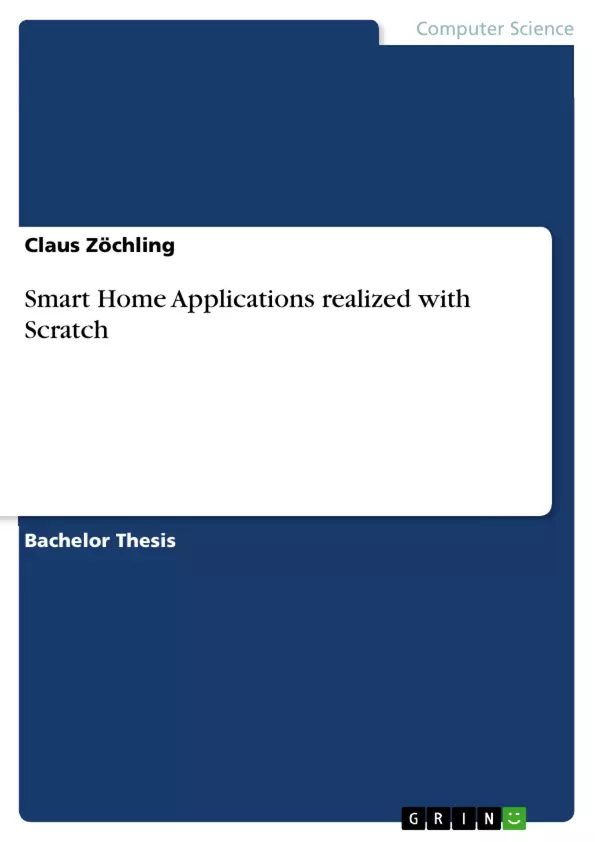For many years, smart home applications have played a major role in our households. Real-time monitoring everywhere via the web, retracting the awning at sunset or lighting tasks by movement: the versatility and flexible adaptation is normally reserved for more expensive systems.
The aim of this thesis is to develop a radio board that offers the possibility to integrate all devices in the frequency range of 433 MHz due to a learning function except modules using rolling code or hoping code. Furthermore, a software interface to the programming language Scratch was developed, with which children and programming beginners can already program simple smart home applications without prior knowledge.
In addition to the hardware and software requirements, the design of the circuit on a breadboard, the test of the prototype and the implementation of the software are described in this thesis. Finally, a simple smart home scenario will be programmed with the visual programming language Scratch.
Inhaltsverzeichnis (Table of Contents)
- Introduction and Motivation
- Concept and technical Requirements
- Concept
- Hardware Concept
- Software Concept
- Technical Demands
- Implementation
- Hardware Construction on the Breadboard
- Communication Atmel - Raspberry Pi
- Transmission of Radio Signals
- Comparison of Radio Receivers
- Prototyp
- Printed Circuit Board
- Testing Prototyp
- Software Implementation
- Implementation on the Rasperry Pi and Usage with Scratch
- Implementation on the ATmega328P
- Hardware Construction on the Breadboard
- Application Scenario
- Summary
Zielsetzung und Themenschwerpunkte (Objectives and Key Themes)
The aim of this thesis is to develop a radio board that can be used to integrate various devices in the 433 MHz frequency range, allowing for the creation of a flexible and customizable smart home system. The focus is on achieving interoperability with different manufacturers' devices and making the system accessible for non-professionals through a visual programming interface. This project utilizes the Raspberry Pi and an Atmel microcontroller to create a versatile platform for smart home applications.
- Developing a radio board for smart home applications.
- Enabling interoperability with devices from various manufacturers in the 433 MHz frequency range.
- Creating a visual programming interface for easy use and accessibility for non-professionals.
- Utilizing the Raspberry Pi and Atmel microcontroller for flexible and adaptable smart home functionalities.
- Exploring time-controlled and sensor-controlled tasks for smart home scenarios.
Zusammenfassung der Kapitel (Chapter Summaries)
- Introduction and Motivation: This chapter provides an overview of the increasing popularity of smart home applications and highlights the need for a flexible and affordable solution for integrating various devices in the 433 MHz frequency range. It emphasizes the importance of user-friendly programming interfaces and the potential for both professional and non-professional users to benefit from the system.
- Concept and technical Requirements: This chapter outlines the concept of the project and describes the technical requirements for its implementation. It delves into the hardware and software aspects, including the selection of the Raspberry Pi and Atmel microcontroller for their flexibility and adaptability.
- Technical Demands: This chapter explores the specific technical demands of the project, detailing the communication protocols, radio transmission, and the need to address compatibility issues with different manufacturers' devices.
- Implementation: This chapter describes the hardware and software implementation process, including the construction of the circuit on a breadboard, testing the prototype, and developing the software to meet the programming requirements.
- Application Scenario: This chapter simulates a possible user scenario, demonstrating how the system integrates radio modules, performs time-controlled and sensor-controlled tasks, and allows for user customization.
Schlüsselwörter (Keywords)
The primary keywords and focus topics of this paper are smart home, radio board, Raspberry Pi, Scratch, 433 MHz frequency range, interoperability, user-friendly programming interface, and flexible customization.
- Quote paper
- Claus Zöchling (Author), 2017, Smart Home Applications realized with Scratch, Munich, GRIN Verlag, https://www.grin.com/document/371088



